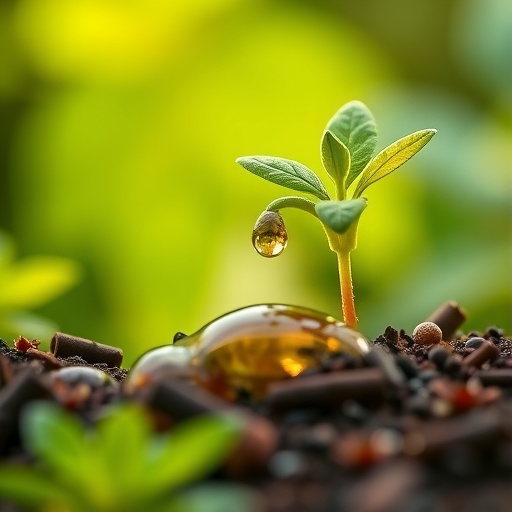In recent years, the environmental impact of oil drilling has drawn significant attention from both scientists and the public, particularly in arid regions where such activities can exacerbate ecological instability. A recent study by Haddadi and colleagues, published in “Environmental Science and Pollution Research,” highlights a groundbreaking approach to mitigate this issue through the enhancement of plant-assisted microbial remediation techniques. This research not only sheds light on innovative solutions for environmental restoration but also emphasizes the critical role that plants can play in managing pollutants in challenging ecosystems.
The study focuses on oil drill cuttings, a hazardous waste byproduct of oil extraction processes. When left unmanaged, these cuttings can negatively affect soil quality, water resources, and local flora and fauna. Most concerning is the fact that the residual hydrocarbons and toxic compounds from these cuttings pose a significant threat to biodiversity and the health of ecosystems. Traditionally, remediation efforts have relied heavily on chemical treatments and mechanical methods; however, these approaches often fall short of achieving long-term ecological viability. This is where the innovative solutions proposed by Haddadi et al. come into play.
The researchers explored the synergistic relationship between specific plant species and microbial communities that can thrive in harsh environments typical of arid areas. By employing a combination of phytoremediation—where plants are used to absorb and stabilize contaminants—and enhanced microbial degradation, the authors demonstrate a new pathway towards ecological restoration. This dual approach not only increases the efficiency of pollutant breakdown but also promotes soil health and stabilizes nutrient cycles within the affected area.
One of the major implications of this study is its potential to redefine how remediation strategies are developed in arid regions. The research indicates that certain plants can enhance the bioavailability of pollutants, making them more accessible to degrading microbes. This is particularly critical in environments where traditional remediation techniques may overlook the adaptability and resilience of natural organisms. By harnessing these natural processes, scientists can create sustainable solutions that maintain ecological integrity while effectively managing pollutants.
Moreover, Haddadi and his team conducted extensive field trials that demonstrated the effectiveness of their proposed methods in real-world conditions. The trials included a diverse mix of plant species chosen for their compatibility with local ecosystems, as well as their proven ability to enhance microbial activity in contaminated soils. Results showed a marked improvement in the breakdown of hydrocarbons, highlighting the potential for significant environmental recovery in affected areas.
The research also delves into the mechanisms behind plant-microbe interactions during the remediation process. Various metabolites produced by plants can stimulate microbial growth, leading to an increase in populations of hydrocarbon-degrading bacteria. Understanding these interactions not only unveils the complex dynamics of plant-soil-microbe relationships but also provides a roadmap for optimizing future remediation efforts. Such insights could pave the way for the development of tailored bioremediation strategies that account for the specific characteristics of contaminated environments.
Additionally, the findings emphasize the importance of local collaborations and community engagement in environmental restoration projects. The authors advocate for involving local stakeholders, including indigenous populations, in conservation efforts, which can enhance knowledge transfer and elicit a deeper connection to the work being done. Educating communities about the benefits of integrating natural processes into remediation strategies ensures broader support and success of these initiatives.
The study also contributes to the broader scientific discourse on climate resilience and adaptation. Arid regions are increasingly susceptible to the adverse effects of climate change, including prolonged droughts and extreme weather events. By promoting the health of soil ecosystems through innovative remediation techniques, researchers can help strengthen the resiliency of these regions. This strategic approach not only addresses immediate contamination concerns but also helps ensure the long-term sustainability of vital natural resources.
In light of the study’s findings, there is a call to action for policymakers and environmental organizations to prioritize funding for similar research initiatives. The potential scalability of these plant-assisted microbial remediation techniques could transform remediation practices globally, especially in other regions grappling with the challenges posed by industrial waste. Such initiatives could address the pressing need for sustainable and effective environmental management practices tailored to local contexts.
Furthermore, the work of Haddadi et al. serves as a powerful reminder of the interconnectedness of ecosystems. Every organism, whether plant or microbe, plays a crucial role in maintaining ecological balance. By understanding and leveraging these relationships, we can develop approaches that promote ecological restoration rather than causing further harm. This research exemplifies the innovative thinking required to address pressing environmental challenges in a sustainable and responsible manner.
In conclusion, Haddadi and colleagues’ research on enhanced plant-assisted microbial remediation presents a forward-thinking approach to managing oil drill cuttings in arid regions. By integrating plant biology with microbial processes, the authors highlight a sustainable pathway for ecological restoration. There is a growing recognition within the scientific community of the need for innovative and adaptive solutions to environmental problems, and this study contributes significantly to that discourse. As we continue to forge ahead in replacing traditional remediation practices with more holistic approaches, the power of nature’s own mechanisms cannot be overlooked.
As the global community faces increasing pressures from industrialization and climate change, studies like this will become essential in guiding effective and sustainable practices. The implications of this research extend beyond just the immediate concerns of pollution; it invites us to rethink our relationship with nature and pursue methodologies that honor the intricate connections within our ecosystems. In doing so, we pave the way toward a more harmonious coexistence with the environment while safeguarding its future for generations to come.
Subject of Research: Plant-assisted microbial remediation of oil drill cuttings in arid areas
Article Title: Enhanced plant-assisted microbial remediation of oil drill cutting from arid areas
Article References:
Haddadi, S., Cagnon, C., Benamara, MM. et al. Enhanced plant-assisted microbial remediation of oil drill cutting from arid areas.
Environ Sci Pollut Res (2025). https://doi.org/10.1007/s11356-025-36976-2
Image Credits: AI Generated
DOI:
Keywords: Oil drill cuttings, phytoremediation, microbial degradation, arid regions, environmental restoration, ecological resilience.




